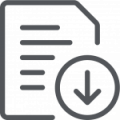Supporting Sexual and Reproductive Health
Audit snapshot
What we examined
We examined whether Victorian women can readily access sexual and reproductive health (SRH) information and services to support their health and wellbeing.
Agencies examined: Department of Health (the department) and 4 service providers – Women's Health Victoria, Monash Health, Gippsland Lakes Complete Health and Bendigo Community Health Services.
Why this is important
Women need access to SRH services to stay well and make critical choices about their lives, including if and when to have children. The United Nations affirms the critical importance of access to SRH services and has included it as a target in its Sustainable Development Goals.
Since 2017, the Victorian Government has set up 1800 My Options (a phone line and website) and 11 SRH hubs (clinics) to improve access to SRH information and services. Victorians need to know if these programs are achieving this, particularly for those the government has identified as priority groups.
What we concluded
There are areas in Victoria where women cannot readily access SRH services.
While the 1800 My Options service allows Victorian women to readily access SRH information, the department does not know if its hubs are improving women and priority groups' access to SRH services because it does not have:
- a full understanding of service gaps and demand across the state
- performance measures to monitor the hubs' ability to improve service access.
What we recommended
We made 3 recommendations to the department to:
- undertake a comprehensive SRH service demand and gap analysis for the whole of Victoria
- develop relevant outcome performance measures for 1800 My Options and the hubs
- work with department-funded SRH service providers to confirm and implement performance reporting requirements.
Video presentation
Key facts
Source: VAGO.
Support options
Our report discusses sexual and reproductive health issues that may be sensitive for some readers. These matters include unwanted pregnancy and its termination and sexually transmitted infections.
These topics can trigger distress or sadness for some people, particularly survivors of difficult or traumatic experiences. Support is available.
Beyond Blue
Beyond Blue is a mental health organisation with a focus on assisting people affected by anxiety, depression or suicide.
Phone: 1300 22 4636
Headspace
Headspace is a national youth mental health foundation that provides early intervention mental health services to 12–25-year-olds.
The foundation supports young people with mental health, physical health (including sexual health), alcohol and other drug support services.
Lifeline
Lifeline is a national charity that offers all Australians experiencing a personal crisis access to 24 hour crisis support and suicide prevention services.
Phone: 13 11 14
1800RESPECT
1800RESPECT provides information, referral and counselling services to people experiencing or at risk of experiencing sexual assault, domestic or family violence.
It is also available to friends, family and professionals. 1800RESPECT provides a confidential service 24 hours a day, 7 days a week.
Phone: 1800RESPECT (1800 737 732)
Our recommendations
We made 3 recommendations to the Department of Health to address 2 issues. The department has accepted them.
| Key issues and corresponding recommendations | Agency responses | |||||
|---|---|---|---|---|---|---|
| Issue: The Department of Health does not fully understand sexual and reproductive health service demand and gaps across the state | ||||||
|
Department of Health |
1 |
Undertakes a comprehensive and up-to-date sexual and reproductive health service demand and gap analysis for the whole of Victoria, including:
|
Accepted |
|||
| Issue: The Department of Health does not know if 1800 My Options and the hubs have increased access to sexual and reproductive health services | ||||||
|
Department of Health |
2 |
Develops relevant outcome performance measures for 1800 My Options and the hubs to monitor and report on their achievement of objectives to:
|
Accepted |
|||
|
3 |
Works with department-funded sexual and reproductive health service providers to:
|
Accepted |
||||
What we found
This section summarises the Department of Health's (the department) 1800 My Options and sexual and reproductive health (SRH) hub programs and our key findings. Sections 2 and 3 detail our findings, including supporting evidence.
When reaching our conclusions, we consulted with the audited agencies and considered their views. The agencies' full responses are in Appendix A.
The Plan
Access to affordable, high-quality SRH services is essential for women’s health and wellbeing. In March 2017 the Victorian Government launched its first SRH plan, Women's sexual and reproductive health: Key priorities 2017–2020 (the Plan).
A key objective of the Plan is to increase access to SRH services for Victorian women. To this end, the government provided funding for:
- the phone line and website 1800 My Options
- SRH hubs in 11 locations across Victoria.
- Following the language used in the Plan, this report uses the word ‘termination’ to refer to abortion. We acknowledge that the Victorian women's sexual and reproductive health plan 2022–30 uses the more contemporary and generally widely used terminology of abortion.
1800 My Options
Women’s Health Victoria (WHV) established 1800 My Options. It is Victoria’s first statewide SRH phone line and website information service on pregnancy options, contraception, termination, sexual health and where to access services.
SRH hubs
From 2017 the department provided funding to establish 8 initial SRH hubs – 4 in regional Victoria and 4 in Melbourne. The hubs provide services such as testing for sexually transmitted infections (STIs) and clinical services for long-acting reversible contraception and medical termination.
In 2021–22 the government allocated further funding for 3 additional regional hubs and to expand existing hubs’ operating hours and scope of services.
Key findings
Our findings fall into 3 key areas:
|
1 |
The department does not have a fully understanding of SRH service demand and gaps. |
|
2 |
The department does not know if its hubs have improved access to SRH services. |
|
3 |
1800 My Options has increased access to SRH information, but the department does not know if it has improved access to SRH services. |
Key finding 1: The department does not fully understand SRH service demand and gaps
Understanding service gaps
The department does not have a complete list of SRH service providers in the state.
This means the department does not know if it has placed the hubs where women most need them.
2016 service gap review
Before it established SRH hubs, the department commissioned a review of the service gaps in Victoria. The review was not comprehensive because it did not determine the number and location of SRH service providers across the state.
Based on partial data, the review noted some geographic gaps and hubs were placed in some of these locations, such as Gippsland and southern metropolitan Melbourne.
The department has still not addressed some service gaps in metropolitan Melbourne and regional and rural Victoria.
Areas with few or no SRH services
Out of 79 local government areas (LGAs) in Victoria, 11 have an established hub. While there is considerable need for SRH services in the LGAs containing the hubs we audited, there is an even higher need in growing metropolitan LGAs with no hubs.
There are 15 LGAs in regional Victoria that have fewer than 2 SRH providers registered with 1800 My Options. This includes:
- 5 rural LGAs have no registered SRH services
- 10 rural LGAs have only one registered SRH service.
This suggests that residents from these areas need to travel outside their LGAs to seek SRH services.
Gaps in termination care
Based on calls received by 1800 My Options, medical and surgical terminations are the most requested SRH service in Victoria. From March 2018 and January 2023, over 85 per cent of calls to 1800 My Options related to termination services.
However, available data shows that as at January 2023, 17 regional and rural LGAs have no registered medical or surgical termination providers.
Key finding 2: The department does not know if its hubs have improved access to SRH services
Understanding program impact
A performance monitoring program with relevant outcome performance measures will enable the department to know if its hubs are enabling more women to access SRH services.
Outcome performance measures
The department collects data on whether hubs are providing the SRH services it requires them to. But it has not set outcome performance measures to track the achievement of the Plan's objectives.
This means it cannot determine whether women’s access to SRH services has improved since it established the hubs and whether they are the best use of government resources to address SRH access issues.
It also means that it does not know the extent to which access by priority groups has improved. The department told us it did not identify outcome performance measures and targets for hubs to avoid creating situations that may interfere with a person’s ability to make independent decisions about their own reproductive health.
For example, if performance targets are set towards the number of services, such as medical terminations, it may influence staff to recommend these services to meet the targets.
There is the potential that performance measures that are not appropriately thought out and drafted may result in staff influencing patients’ decisions about their bodies. However, this does not take away the department’s responsibility to develop appropriate and relevant performance measures for its programs.
Currently, without relevant performance indicators, the department cannot tell the extent to which the audited hubs’ services are supporting women who find it difficult to access services. It also does not know if these patients could have easily secured these services from other nearby providers.
The choice of relevant and appropriately worded outcome performance measures would allow the department to cover these data gaps while avoiding influencing patients' decisions.
Reporting on output measures
The department monitors output measures relative to the number of services the hubs provide. However, it did not start collecting this information until 2 years after the program started.
The department told us this was because there was little value in collecting data from a small number of hubs while they were still developing.
Performance monitoring at program start is important for highlighting areas where the program can be refined and improved. The department missed this opportunity.
Key finding 3: 1800 My Options has increased access to SRH information, but the department does not know if it has improved access to SRH services
Increased access to information
1800 My Options is an important resource for Victorian women to know more about their SRH and where to seek SRH services. In the Nossal Institute for Global Health’s evaluation of 1800 My Options, users reported better:
- knowledge of the services available for their SRH
- awareness of the different aspects of care they need
- understanding of their rights and options through up-to-date information and corrections of SRH misinformation.
1800 My Options is also making more women aware of SRH hubs. Its service provider database lists all the hubs, including those we audited.
WHV monitors whether 1800 My Options is reaching 5 of the 6 priority groups identified in the Plan. It currently does not get information on gender-diverse people.
Access to services
1800 My Options provides information about SRH services registered in its database. A ‘registered’ SRH service provider means it is listed in 1800 My Options' service provider database and has consented for women to be informed of its services when they contact the phone line.
1800 My Options staff suggest 3 service providers to each caller seeking care. However, the department does not know if these calls result in actual SRH appointments.
The department does not have relevant performance measures to evaluate how 1800 My Options impacts service access. The department does not track whether 1800 My Options calls result in appointments at the SRH service providers it funds. This means it cannot assess whether 1800 My Options is improving women’s access to SRH services overall.
1. Context
From 2017 the department introduced several programs to help Victorian women access SRH services.
In this audit, we looked at the 2 main programs: 1800 My Options and SRH hubs.
About SRH services
Sexual and reproductive health
SRH services support people with various aspects of their health and wellbeing, including:
- contraception, such as contraceptive implants, hormonal or copper intra-uterine devices (IUDs), contraceptive injections, oral contraceptives and emergency contraception
- pregnancy options, including pre and post-birth care, options for adoption, options for termination and counselling
- medical and surgical termination of pregnancy
- preventing, detecting and treating STIs
- antenatal health, miscarriage and birth
- menstrual health and menopause
- conditions such as polycystic ovary syndrome and endometriosis.
Who SRH services are for
Everyone's SRH is important. The programs we audited support women, girls, and gender-diverse people, including non-binary people and transgender men.
Because women are by far the largest group of people to use the hubs and 1800 My Options, we will often refer to general users of these services as women throughout this report.
However, we acknowledge that people who are not women also use and rely on these services and that different people have diverse SRH needs throughout their lifetimes.
Access to SRH information and services before the programs
Source of SRH information
Before 1800 My Options, the Royal Women’s Hospital was Victorian women's main source of information about SRH.
Women also relied on their general practitioners (GPs) or word-of-mouth referrals to find out what SRH services were available, where they were and how to access them.
There was no centralised, state-wide resource to find out about SRH services, either online or over the phone.
SRH services
SRH services in Victoria include public and private providers located in various parts of the state.
Many private clinics do not bulk-bill. The key public providers, such as the Royal Women’s Hospital, are based in Melbourne and not readily accessible to those from regional and rural Victoria.
Many Victorians can also access SRH support through government-funded community health centres.
The Plan, 1800 My Options and the hubs
The Plan
In March 2017 the department launched the state's first SRH plan, Women’s sexual and reproductive health: Key priorities 2017–2020 (the Plan).
The Plan notes that exercising reproductive choices is critical to women’s reproductive and general health. In their foreword to the Plan, the then Minister for Health noted that ‘there are parts of Victoria where there is little or even no access to the information, support and services that women require’.
The Plan aims to address barriers and gaps affecting women’s access to affordable healthcare, contraception, and termination services across the state.
Priority groups
While the Plan aims to support all Victorians, it said that it will prioritise the SRH needs of key groups of people:
- adolescent, young and older women
- Aboriginal and Torres Strait Island people
- people from culturally and linguistically diverse backgrounds
- people living in regional and rural Victoria
- people with disability
- women in same-sex relationships and gender-diverse people.
The programs
Between 2016–2017 and 2019–2020, in line with the Plan, the government invested $6.89 million to improve access to SRH services.
Nearly 60 per cent of this funding went to the establishment of 2 programs:
- 1800 My Options, which is a phone line and website
- SRH hubs in 8 areas across Victoria.
We audited these programs because they received the bulk of the funding, as Figure 1 shows.
Figure 1: Breakdown of funding for SRH programs, 2017–2020 (in millions)
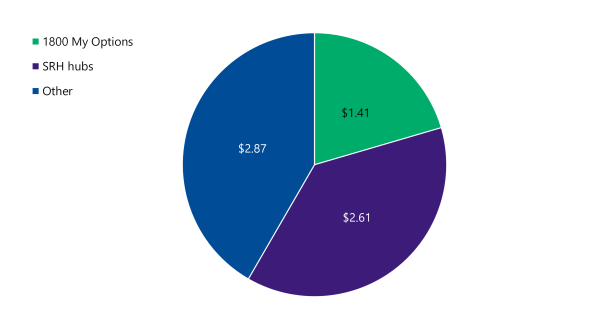
Source: VAGO based on department data.
1800 My Options
In 2018 the department funded WHV to establish 1800 My Options, which is Victoria’s first state-wide SRH phone line and website.
1800 My Options gives women information on where and how to access SRH services, including contraception, counselling and termination. The website also has a geographically mapped database of SRH providers.
Registration on this database is voluntary, so it does not list some providers. Some registered providers request to be privately listed. This means that their information is not publicly available in 1800 My Options' website, but staff are able to refer callers to these providers. Privately listed providers account for 15 per cent of all registered providers.
The department aims to see caller numbers and registered providers rising because this would indicate growing awareness about the service.
SRH hubs
In 2017 the department allocated funding to establish 8 SRH hubs. To receive department funding, the hubs must:
- provide information for all forms of contraception and termination options
- offer clinical services to women who opt for long-acting reversible contraception
- offer clinical services for women who opt for medical termination
- develop referral pathways for women who require surgical termination
- provide sexual health testing, treatment and support.
Hub locations
Hubs are usually based in community health centres. In some cases, a single hub offers services from more than one site.
In this audit we considered the department’s management of the first 8 hubs and the activities of 3 hubs – Monash Health (Monash hub), Gippsland Lakes Complete Health (Gippsland hub) and Bendigo Community Health Services (Bendigo hub).
In 2021–22 the government allocated further funding to establish 3 new regional hubs in Shepparton, Morwell and Warrnambool and expand the operating days and scope of services at existing hubs.
As Figure 2 shows, there are currently 11 hubs – 7 in regional Victoria and 4 in metropolitan Melbourne.
|
Regional hub |
Sites |
|---|---|
|
Ballarat Community Health |
Lucas, Sebastopol and Wendouree |
|
Bendigo Community Health Services |
Bendigo and Eaglehawk |
|
Gippsland Lakes Complete Health |
Bairnsdale |
|
Gateway Health |
Wangaratta and Wodonga |
|
Latrobe Community Health Service |
Morwell |
|
Primary Care Connect |
Shepparton |
|
South West Healthcare |
Warrnambool |
|
Melbourne hub |
Sites |
|---|---|
|
cohealth |
Fitzroy, Footscray and Laverton |
|
EACH |
Ringwood East |
|
Monash Health |
Cranbourne and Dandenong |
|
Peninsula Health |
Frankston, Hastings and Rosebud |
Figure 2: Hub locations across Victoria
Source: VAGO based on department data.
Additional hubs
The government started funding the hubs in 2017 and has since set up 11 hubs. This means some hubs are more established at delivering services than others.
There is no standardised model of service delivery for hubs. Each organisation responds to its own geographic, cultural and structural context.
Hub funding
Audited hubs receive baseline funding from the department. The base amounts progressively increased each year. In 2022, indicative funding was $150,000 per hub*.
*Note: Departmental funding includes GST when provided to a community health centre.
What we examined
|
We audited ... |
Which is … |
And … |
|---|---|---|
|
Department of Health |
the state’s health system manager |
|
|
Women's Health Victoria (WHV) |
a state-wide women's health, advocacy and support service |
runs 1800 My Options with funding from the department. |
|
Monash Health |
a large public health service and hospital operator |
runs a hub with sites in Cranbourne and Dandenong. |
|
Gippsland Lakes Complete Health |
a regional community health centre |
runs the Gippsland hub in Bairnsdale, known as Clinic 281. |
|
Bendigo Community Health Services |
a regional community health organisation |
runs the Bendigo hub from its primary site in central Bendigo and additional site in Eaglehawk. |
What we did not examine
Department of Families, Fairness and Housing
We initially intended to examine the Department of Families, Fairness and Housing (DFFH). But it and the department have since confirmed that DFFH does not monitor the hubs or 1800 My Options, so we have not included it in this audit.
Recent policy updates
In 2022 the government introduced the 'Victorian sexual and reproductive health and viral hepatitis strategy 2022–30'.
This strategy was informed by extensive consultation with over 280 participants in the SRH sector, including feedback on the previous strategy’s gaps and key opportunities. This consultation also prompted the department to establish an SRH working group and start developing a monitoring and indicators framework.
The strategy consists of 7 plans:
- one 'system enabler' plan to strengthen the SRH and viral hepatitis service systems
- 6 plans to address specific diseases or to support specific population groups.
One of these 6 plans is the new Victorian women’s sexual and reproductive health plan 2022–30.
2. Sexual and reproductive health hubs
The department does not know if its hubs have increased Victorian women’s access to SRH services. This is because it is does not have relevant performance measures to determine if, and the extent to which, this program is achieving the Plan’s objective to increase access to services.
It is also not clear that the department placed the hubs where women need them most.
Access to SRH services
Importance of access to SRH services
SRH issues are time sensitive. Victorians need easy and timely access to SRH care, including services for:
- safe and legal termination
- STI prevention and recovery
- effective contraception.
International human rights law and the United Nations' Sustainable Development Goals both recognise the importance of SRH, including bodily autonomy – a person's right to make choices about their own body.
The rights highlight a need for states to ensure access to SRH services, including termination, and remove any obstacles that deny access.
Termination laws in Victoria
In Victoria, a woman can legally terminate a pregnancy within prescribed timeframes. Not being able to access appropriate SRH services during these periods may result in the option to have a medical termination being lost or not being able to have a legal termination.
The Abortion Law Reform Act 2008 (Vic) allows surgical termination for pregnancies less than 24 weeks. After this period, 2 medical practitioners must agree that surgical termination is appropriate.
Medical termination is where a woman takes medication to abort the pregnancy. This is allowed up to 63 days, or 9 weeks, from gestation.
Prescribers of termination medication
Only GPs who have undertaken mandatory training can prescribe termination medication. Available information indicates that at June 2022, 1,054 Victorian GPs have undertaken this training. This represents roughly 13 per cent of all registered Victorian GPs.
STI care
Difficulty accessing timely care may also lead to serious health consequences for people with STIs. These consequences can include infertility, chronic disease such as cancer, and death. STI cases are a growing concern for Victoria.
SRH service demand and gaps
Hub locations and service needs
The department does not have a complete list of all SRH providers operating across Victoria, including where they are and the SRH services they provide.
This means it does not fully understand the nature and extent of service gaps. This limits the department's ability to determine the best location for its hubs to improve women's access to care.
Our analysis of available information suggests that current hub locations are not consistent with women’s SRH needs across the state. The department could make better use of available service demand data to understand where to put its hubs to best improve SRH service access.
We analysed the need for SRH services based on the number of callers to 1800 My Options and the availability of registered SRH service providers. This data suggests service gaps in some areas without hubs.
Figure 3 shows that while there is considerable demand for SRH services in the LGAs where the audited SRH hubs are located, there is an even higher demand in the growing metropolitan LGAs of City of Wyndham, City of Hume, City of Melton and City of Whittlesea. There are no SRH hubs in these LGAs.
Figure 3: 1800 My Options calls (March 2018 to January 2023) compared to registered SRH providers on database (as at January 2023)
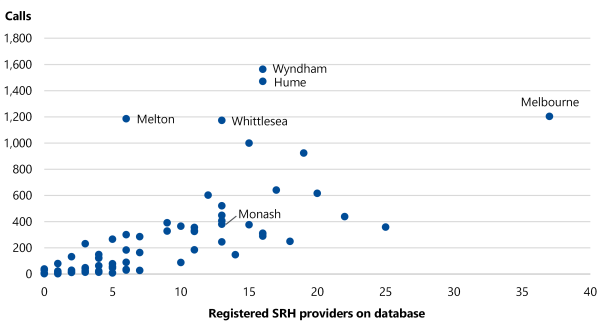
Note: Calls are matched to LGAs based on callers' indicated postcode.
Source: VAGO from WHV data.
Figure 4 shows that when looking at the LGAs with the highest call rate to 1800 My Options, 7.7 per cent and 7.3 per cent are from Wyndham and Hume respectively. In contrast, these LGAs each have only 2.6 per cent of registered service providers. Similarly, 5.9 per cent of callers are from Melton but the LGA only has 1.0 per cent of the registered providers.
In contrast, Monash, which has an SRH hub, has a relatively lower percentage of callers at 1.9 per cent while having a relatively similar percentage of registered service providers as Wyndham and Hume. Moreover, while Melbourne has a high rate of callers at 6.0 per cent, it has the highest percentage of registered providers at 6.1 per cent.
This comparison suggests that while there is a high demand in these northern metropolitan LGAs, they have low rates of registered providers.
Figure 4: 1800 My Options calls (March 2018 to January 2023) and LGA registered providers
| LGA | Number of calls | % of calls | Number of providers | % of providers |
|---|---|---|---|---|
| Wyndham | 1,564 | 7.7% | 16 | 2.6% |
| Hume | 1,471 | 7.3% | 16 | 2.6% |
| Melbourne | 1,204 | 6.0% | 37 | 6.1% |
| Melton | 1,186 | 5.9% | 6 | 1.0% |
| Whittlesea | 1,174 | 5.8% | 13 | 2.1% |
| Monash | 380 | 1.9% | 13 | 2.1% |
Note: This table shows the top 5 LGAs from where the highest number of 1800 My Options callers indicated they are from. Monash is included as a comparison. For a full list of all 79 Victorian LGAs, please see Appendix D.
Source: VAGO from WHV data.
2016 service capacity review
Out of 79 LGAs in Victoria, 11 have an established hub.
The department used a review it commissioned in 2016 to determine where to place its hubs. The review’s findings include that:
- the largest proportion of long-acting reversible contraception insertions occurred in the southern metropolitan region
- women living in Gippsland consistently reported the longest travel times to get terminations
- there are few rural SRH service providers.
The department attempted to address some of these identified gaps by establishing a hub in southern metropolitan Melbourne and 4 hubs in regional Victoria, including in Gippsland. In 2021–22, the department allocated funding towards 3 hubs in Shepparton, Morwell and Warrnambool.
However, because the department did not, and still does not, know the total number of SRH providers across Victoria, including their locations and services, it cannot tell if it placed the hubs in areas where women need them most.
Rural areas with no registered SRH providers
There are 15 rural LGAs in Victoria that have fewer than 2 registered SRH providers:
- 5 have none
- 10 have one.
This suggests that residents from these areas need to travel outside their LGA to seek SRH services.
Termination providers
Figure 5 shows that based on calls to 1800 My Options, medical and surgical terminations are the most requested SRH service in Victoria. From March 2018 to January 2023, over 85 per cent of calls to 1800 My Options related to termination services.
However, available data shows that as at January 2023, 17 regional and rural LGAs have no registered medical or surgical termination providers on 1800 My Options.
Figure 5: Top reasons for calling 1800 My Options, March 2018 to January 2023
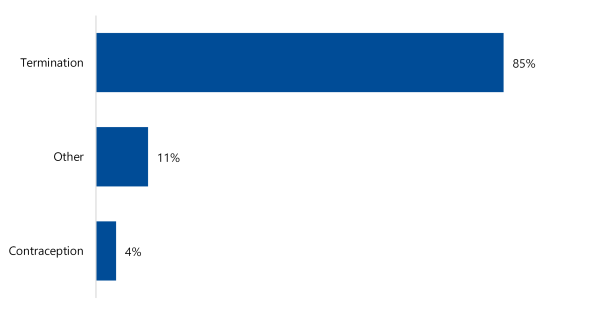
Note: 'Other' includes STI and counselling services.
Source: VAGO from 1800 My Options data.
Impact of limited access to SRH services
WHV's records on phone calls to 1800 My Options show the challenges women face when SRH services are not readily accessible.
WHV told us that a recent caller from regional Victoria sought advice for terminating a pregnancy and faced difficulties due to regional service access gaps. 1800 My Options helped her secure an appointment with an SRH provider, who cancelled at the last minute due to illness.
As there were no other registered medical or surgical termination provider near her, this impacted her options for termination.
Steps to understand service demand and gaps
The department has recently taken steps to better understand service demand and gaps across the state through the Victorian Women’s Health Atlas, which is an online resource that collects and shares SRH data.
The department is also considering ways to access Australian Government patient data from private GP visits. It hopes to link this data with state hospital data to track a patient’s journey. This information is not currently available to the department.
Have hubs improved access to SRH services?
Outcome performance measures
To understand if a program is achieving its objectives, program managers need to identify and monitor relevant outcome performance measures.
Output performance measures are used to monitor a program’s activities. For example, the number of long-term contraception procedures a hub does in a year.
Outcome performance measures are used to monitor a program’s impact. For example, whether the proportion of women from priority groups who can access long-term contraception is increasing.
A performance monitoring program with relevant outcome performance measures will enable the department to know if its hubs are allowing more women to access SRH services.
Hub impact on access to SRH services
The department has no outcome performance measures for its hubs.
Without relevant performance measures, the department does not know the extent to which hubs provide services to women who find it hard to access SRH care. It also does not know whether these women could have easily secured these treatments from other nearby SRH providers.
This means the department has a limited ability to know how effective the hubs are and whether they are the best use of government resources to address SRH access issues.
For example, Figure 6 below shows that for the period July 2019 to June 2022, the average cost per service ranged from $1,314 to $4,488 for Monash hub and $952 to $14,025 for Gippsland hub. Without a performance monitoring program, the department is not able to ensure that the program provides value for money.
Figure 6: Services audited hubs provided from July 2019 to June 2022
| Monash hub | Bendigo hub | Gippsland hub | ||||||||
|---|---|---|---|---|---|---|---|---|---|---|
| Service | 2019–20 | 2020–21 | 2021–22 | 2019–20 | 2020–21 | 2021–22 | 2019–20 | 2020–21 | 2021–22 | Total |
| IUD insertions | 3 | 39 | 43 | 121 | 104 | 219 | 0 | 0 | 7 | 536 |
| Contraceptive implant | 0 | 3 | 3 | 128 | 298 | 146 | 0 | 2 | 9 | 589 |
| Contraceptive injection | 0 | 0 | 0 | 120 | 130 | 102 | 0 | 0 | 2 | 354 |
| Medical termination | 0 | 0 | 0 | 99 | 176 | 167 | 0 | 1 | 25 | 468 |
| Counselling for medical termination | 0 | 3 | 0 | 13 | 13 | 55 | 0 | 2 | 14 | 100 |
| Surgical termination referral | 3 | 1 | 0 | 18 | 14 | 52 | 0 | 1 | 5 | 94 |
| STI treatment | 19 | 51 | 18 | 1,686 | 8,320 | 3,998 | 8 | 13 | 61 | 14,174 |
| Total | 25 | 97 | 64 | 2,185 | 9,055 | 4,739 | 8 | 19 | 123 | 16,315 |
| Annual funding | $112,200 | $127,500 | $127,500 | $113,135 | $115,398 | $127,500 | $112,200* | $124,148* | $117,150* | - |
| Average cost per service | $4,488 | $1,314 | $1,992 | N/A | N/A | N/A | $14,025 | $6,534 | $952 | - |
Note: The hubs use the department’s funding to cover the costs of establishing the service, including the infrastructure required; establishing relationships and referral pathways with service providers; resourcing staff requirements and training; engagement with clients, including vulnerable groups; and providing standard business overheads.
*Annual funding costs indicated are exclusive of GST.
Source: VAGO based on the department and audited hubs' data.
COVID-19's impact on services
During the periods shown in Figure 6, hubs faced challenges implementing and providing services, which were particularly impacted by the COVID-19 pandemic.
The Gippsland hub was being established over this time and this involved activities such as setting up hub infrastructure and services. The hub also faced difficulties in recruitment and providing all services due to the pandemic.
Similarly, there were periods of time when the Monash hub did not provide services due to the pandemic response. Monash Health staff were redeployed to assist with the management of unwell patients and to staff the state’s testing and vaccination programs. Monash Health also informed us that Melbourne’s lockdowns resulted in a reduction of people seeking medical treatment and further reduced demand for the SRH hub services.
Impact on priority groups' access to services
The Plan said that it would prioritise the SRH needs of key groups. Section 1 lists these priority groups.
However, the department does not know the extent to which Victorians from priority groups have visited or attended hubs since the program started in 2017.
This is because the department does not track and report on this objective of the Plan. While the department requires hubs to report on the number of Health Care Card holders who attend hubs, this by itself does not indicate their inclusion in any of the priority groups.
Department rationale for not measuring performance
The department intentionally did not set outcome performance measures and targets for hubs to avoid creating perverse incentives that could lead to reproductive coercion.
Poorly crafted performance measures may have the unintended consequence of staff influencing patients’ decisions about their bodies. But this does not negate the department’s responsibility to develop appropriate and relevant performance measures for its programs.
Monitoring hub performance need not interfere with women’s reproductive autonomy. Better understanding the hubs’ impact on access to SRH services would help the department protect and advance reproductive autonomy.
The department needs to understand the supply and demand for a service and it needs to be able to monitor both. It does not need to supply a service if it already exists, but it does need to understand whether there is a service gap that the government could address because the market does not or cannot supply that service.
Output performance measures
The department monitors output measures relative to the number of services the hubs provide. However, it did not start collecting this information until 2 years after the program started.
The department told us that it did not collect output performance measures for the first 2 years because there was little value in collecting data from a small number of hubs while they were still developing.
It is important to monitor a program’s performance from its beginning to highlight how to refine or improve it. The department missed this opportunity.
Inconsistent output reporting
The department’s reporting on the number of services hubs provide is not consistent.
The Monash and Gippsland hubs report on the number of SRH services they provide regardless of how many appointments each service takes. The Bendigo hub reports on the number of appointments, or ‘occasions of service’.
For example, a patient’s STI screening, treatment and follow-up visit would consist of 3 appointments. The Monash and Gippsland hubs would report this as one service, but the Bendigo hub would report it as 3 services.
This means that the department cannot compare this output performance measure across the hubs.
This inconsistent reporting has continued for years without the department noticing or clarifying hub reporting requirements. This also limits the department’s understanding of supply and demand for SRH services.
New performance framework
The department acknowledges that it needs to improve its performance evaluation of the hubs. This includes developing relevant outcome performance measures and identifying the relevant data for them.
During audit conduct, the department was developing its SRH monitoring and reporting framework.
Hubs are affordable for Victorian women
Affordable services
One way that hubs can help women access SRH services is by offering affordable care.
The hubs we audited provide services at no cost to patients. Hubs currently bulk-bill for all services, with the exception of IUD insertions at the Bendigo hub. However, the Bendigo hub covers the cost if a patient cannot afford the procedure.
Services to women without Medicare
The hubs we audited cover the costs of women who need SRH services, including those who do not have Medicare or concession entitlements, such as international students. The hubs support these women outside their funding requirements:
- The Monash hub covers non-Medicare-card holders’ costs.
- Women can use travel insurance to pay for services at the Gippsland and Bendigo hubs. These hubs also cover costs if insurance is not available.
3. 1800 My Options
1800 My Options has improved Victorian women's access to SRH information, but the department does not know if it has increased access to SRH services.
1800 My Options has increased women's access to SRH information
1800 My Options
In 2018 the department commissioned WHV to establish and operate 1800 My Options as a state-wide phone line and website service to inform people about SRH care.
1800 My Options gives women free and ready access to SRH information, including where to seek SRH services. It maintains a geographically mapped database of registered SRH providers, which women can use through the 1800 My Options website to find publicly registered services near them.
1800 My Options staff give callers 3 SRH service provider options (which may or may not include a hub) based on the caller's required service, location, financial situation and other needs and factors.
Improving access to SRH information
In the Nossal Institute for Global Health's evaluation of 1800 My Options, users reported better:
- knowledge of the services available for their SRH
- awareness of the different aspects of care they need
- understanding of their rights and options through up-to-date information and corrections of SRH misinformation.
1800 My Options is also making more women aware of SRH hubs. The service provider database lists all the hubs, including those we audited. For example, WHV data tells us that between April 2018 and January 2023, 1800 My Options staff suggested the Bendigo hub to 70 phone callers.
Improving priority groups’ access to information
1800 My Options staff collect data on each caller’s:
- age
- residence (metropolitan or regional/rural)
- socioeconomic status
- cultural background, including whether they are Aboriginal and Torres Strait Islander or were born overseas
- disability (when barriers to access to SRH services are directly related).
The department does not require WHV to collect this information. However, collecting this information enables WHV to monitor whether 1800 My Options is reaching 5 of the 6 priority groups identified in the Plan. It currently does not collect information on gender-diverse people.
Number of callers
Call numbers to 1800 My Options were relatively stable from April 2018 to December 2021 as Figure 7 shows. There has been a noticeable upward trend since January 2022
Figure 7: Quarterly calls received by 1800 My Options (Quarter 2 2018 to Quarter 4 2022)
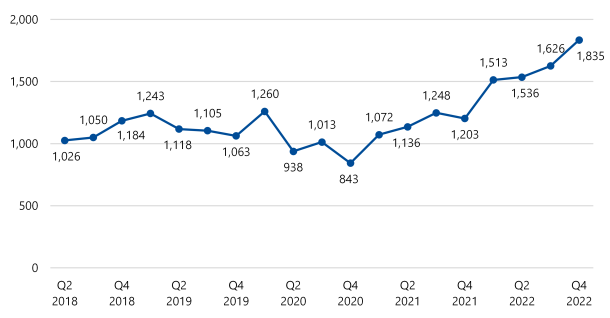
Note: Q stands for quarter using calendar year.
Source: VAGO from WHV data.
Registered SRH providers
The number of registered SRH service providers on the 1800 My Options database grew from March 2018 to January 2023, as Figure 8 shows. Information on most of these providers is available on the 1800 My Options website.
In January 2023 the 1800 My Options database listed 633 SRH providers, including:
- 272 that offer termination services
- 338 that offer other SRH services, including services for STI and contraception
- 23 that offer support services, including counselling.
Figure 8: Registered SRH service providers on 1800 My Options database over time
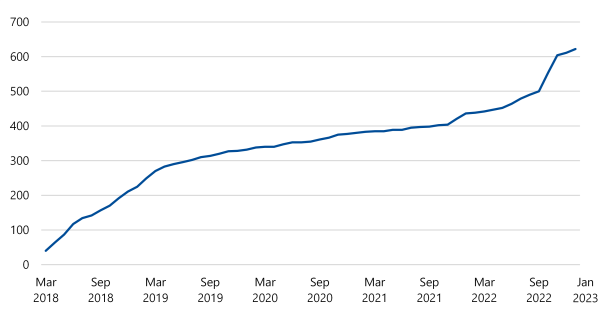
Source: VAGO from WHV data.
Website views
Monthly views of the 1800 My Options website have increased from March 2018, as Figure 9 shows. Views increased significantly from March 2021 to June 2022. This suggests more women are finding out about the website over time.
Figure 9: Monthly page views of 1800 My Options website (March 2018 to June 2022)
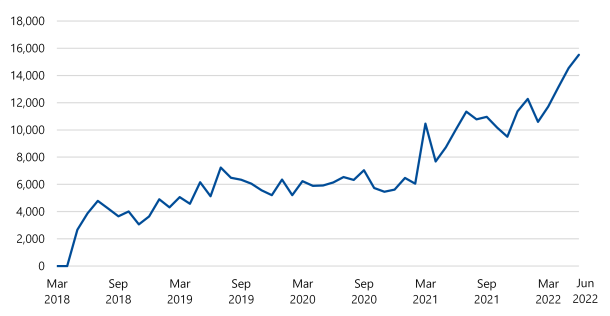
Source: VAGO from WHV data.
Top 3 most viewed pages
After the home page, 'Abortion: what to do' and 'Find a service' are the most viewed pages on the website, as Figure 10 shows.
This reflects previous callers' data we noted, which showed that most women contact 1800 My Options about termination services.
Figure 10: Top 3 most viewed pages on the 1800 My Options website (March 2018 to June 2022)
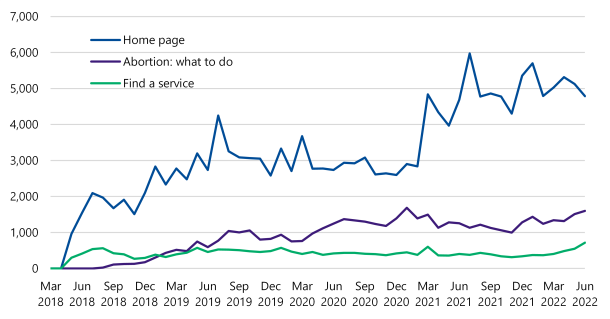
Source: VAGO from WHV data.
The department does not know if 1800 My Options has improved Victorian women’s access to SRH services
Impact on access to services
1800 My Options provides readily available information on 633 SRH providers across the state and its staff suggests 3 of these providers to callers seeking services.
However, the department does not know if these calls result in actual SRH appointments.
The department does not have relevant performance measures to evaluate how 1800 My Options actually impacts women’s service access.
Reporting on access to services
The department currently does not ask the SRH service providers it funds (including hubs) how women found out about their services. Getting this information could inform the department on whether 1800 My Options is increasing service access.
In contrast, the Monash hub asks patients how they heard of their services. From October 2022 to January 2023, 7 patients came to the hub because of 1800 My Options. This highlights that the department could be collecting and tracking this data from hubs.
Output measures
WHV gives the department an annual report on 1800 My Options. WHV and the department agreed that this report should contain:
- total registered providers
- call data, including comparison with the previous year
- the type of service requested by callers, such as surgical and medical termination and contraception
- caller location
- service provider location
- caller issues, if any, such as financial insecurity, mental illness and family violence
- website data
- stakeholder engagement and partnerships.
Appendix A: Submissions and comments
Download a PDF copy of Appendix A: Submissions and comments.
Appendix B: Abbreviations, acronyms and glossary
Download a PDF copy of Appendix B: Abbreviations, acronyms and glossary.
Appendix C: Audit scope and method
Download a PDF copy of Appendix C: Audit scope and method.
Appendix D: 1800 My Options calls (March 2018 to January 2023) and registered service providers
Download a PDF copy of Appendix D: 1800 My Options calls (March 2018 to January 2023) and registered service providers.

